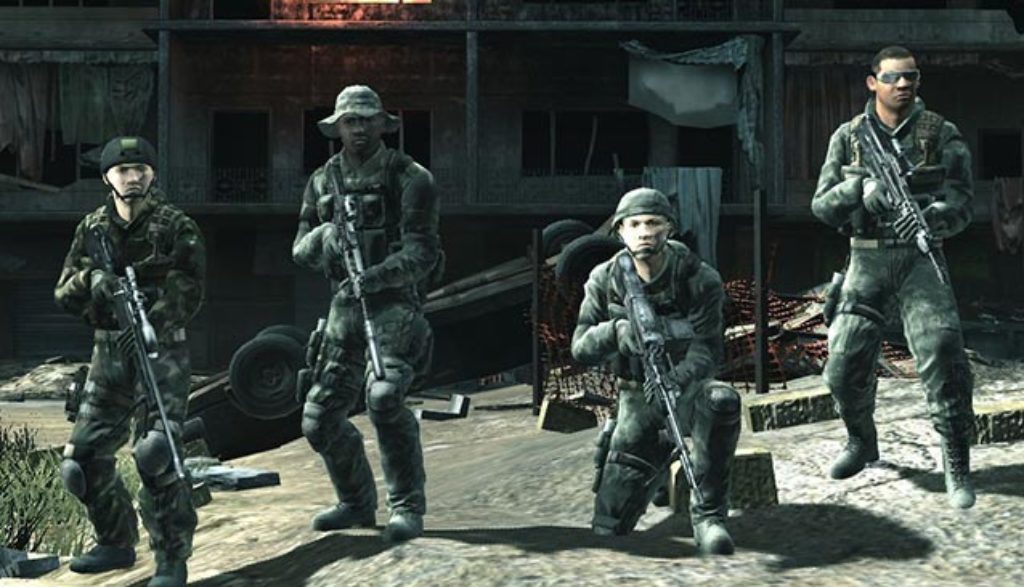
General Heydar Mahmood is a bad man. And the only thing that can keep this despot from destabilizing North Africa with his revolutionary zeal is your fireteam of four SEALs: elite Navy commandos trained for just this kind of special operation. If you survive Morocco’s dusty battlefields, more challenges—specifically, stopping terrorists—await your team in South Asia and Poland.
SOCOM 3: U.S. Navy SEALs is the latest entry in Sony’s special-ops warfare franchise. In this game, your commandos slip into enemy territory to defuse terrorist threats and gather intelligence. The realism of its campaigns eerily mirrors the stories we hear on the news. Indeed, virtual news clips pop up between each stage of the game, making SOCOM 3‘s story line seem quite authentic.
Not Your Average Shooter
If you’ve played video games recently, you know there are myriad titles in the shooter genre—games that put massive firepower in your hands for the purpose of annihilating your enemies. SOCOM 3 definitely belongs in the shooter category, as it doesn’t lack for opportunities to gun down baddies. Yet it also offers several wrinkles that add variety and intrigue. The first mission to take out Mahmood’s organization mostly consists of battlefield ops. But the second and third campaigns require more stealth as you acquire intelligence needed to track down terrorists who are running guns and developing a nefarious weapon of mass destruction.
Unlike popular first-person shooters such as Halo and Resident Evil, it took me quite a while to get my bearings in SOCOM 3. Slowly, I realized that my overall strategy for achieving certain objectives was as important as my ability to aim and fire. For example, the game enables players to give specific commands to the other fireteam members, adding layers of planning and complexity not found in most shooters. When to send my guys ahead and when to regroup were decisions I could only make effectively as I began to understand which situations called for what response. Thus, stealth, teamwork and accuracy are all rewarded. In many cases, simply wandering into the war zone with guns blazing ensured a quick exit.
Future Snipers of America?
SOCOM 3 is rated M for blood and violence. Compared to some other similarly rated fare, however, it actually comes in on the mild side of things. Shooting enemies does result in a spray of blood when they’re hit, and blood also pools beneath downed combatants. That said, the game lacks intense gore—no dismembered limbs are to be found here.
The interactive bloodshed still affected me, though. With each level, my weapons and planning proficiency improved. As that happened I increasingly enjoyed creeping around and using my silenced pistol or my high-powered rifle and scope to take out enemies who never knew I was there. It gave me morbid satisfaction to watch them go down after a well-placed shot. Playing the role of silent hunter easily became the most gratifying part of the game for me.
Now, I don’t think enjoying this aspect of the game is going to turn me (or most players) into real-life snipers. But I do think it’s worth noting that such cold-blooded assassination, even if it’s in the virtual service of one’s country, nevertheless puts players firmly in the boots of ruthlessly efficient killing machines.
In a recent commentary on video game violence, Wired contributor Clive Thompson raised this very concern. “Family values types often deplore the brutality of today’s action titles,” he wrote. “But have they ever closely examined who’s committing this carnage? Nine times out of 10, when you’re blowing people’s chests open with hollow-point bullets, you aren’t playing as a terrorist or criminal. No, you’re playing as a cop, a soldier or a special-forces agent. … Why aren’t these detractors up in arms about, say, [Tom Clancy’s] Rainbow Six series [which is similar to the SOCOM franchise]? Because games lay bare the conservative logic that governs brutal acts. Violence—even horrible, war-crimes-level stuff—is perfectly fine as long as you commit it under the aegis of the state. If you’re fighting creepy Arabs and urban criminals, go ahead—dual wield those Uzis, equip your frag grenades, and let fly. Nobody will get much upset.”
Mr. Thompson makes a good point. And his words of warning are well worth considering, because whether the virtual death our characters deal comes from soldiers or thugs, the result is the same: further desensitization to violence and the devaluing of human life.

After serving as an associate editor at NavPress’ Discipleship Journal and consulting editor for Current Thoughts and Trends, Adam now oversees the editing and publishing of Plugged In’s reviews as the site’s director. He and his wife, Jennifer, have three children. In their free time, the Holzes enjoy playing games, a variety of musical instruments, swimming and … watching movies.